All American: Stuart Davis’ brand of modernism takes over New York
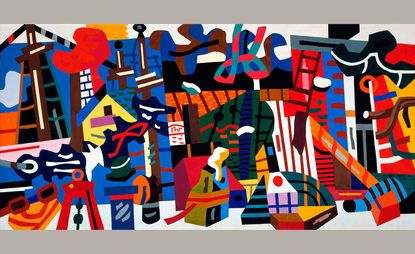
Abstract yet concrete. Geometric, but figurative. Stuart Davis was a painter who lived for the contradiction, and yet somehow found resolution in his mesmerising paintings, heralding him as an American original, a fine art force fueled by aesthetics and politics equally.
This week, the Whitney Museum of American Art opens a retrospective, in conjunction with the National Gallery of Art, titled ‘Stuart Davis: In Full Swing,’ that traces near 100 works from his early paintings in the 1920s to his depictions of consumer products until the 1960s, when his fusion of dynamism and vivid colours led him to neither embrace abstraction fully nor to abandon figuration completely.
It’s fitting for the Whitney to reconsider this artist, whom not only was a personal friend and favourite of Gertrude Vanderbilt Whitney, but was also a founding member of the Whitney Studio Club and had his first solo exhibition at the institution in 1926. While he was a true-blood American, his sense of identity was not the idealised pastoral, but rather formed by the New York streets and Newark's hot jazz joints—modernity was pluralistic, a notion not shared by others in Davis’ time.
As this retrospective shows, though Davis was in all the right places at all the right times, even rubbing elbows with those who went on to be anointed as ‘establishment,’ the most precious dialogue he created was with himself. Take Paris, for example, to which Davis arrived in 1928. While Davis’ works from that period may look like cubist or surrealist extensions, they were anything but.
Throughout the exhibition, the show’s curators, Barbara Haskell and Harry Cooper, consistently remind viewers of this phenomenon: old and new works are placed side-by-side to demonstrate how motifs or ideas from the 1920s remained powerful to Davis throughout his exuberant jazz period, and the 1950s and ’60s. Underscoring Davis’ practice was the notion that art played a social role, and thus throughout his oeuvre, he maintained a formal principle of using only ‘shallow space,’ so the canvas didn’t deceive or seduce unjustly.
While he abstracted his famous eggbeaters (a recurring object in his still lifes), and animated words and jazz notes into geometric symbols, in many ways, Davis saw the future as bright, full-speed and inherently contained.
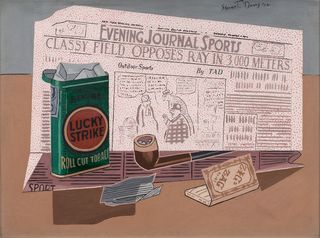
The retrospective, staged together with the National Gallery of Art, traces near 100 works from Davis' early paintings in the 1920s to his depictions of consumer products from the 1960s. Pictured: Lucky Strike, 1924
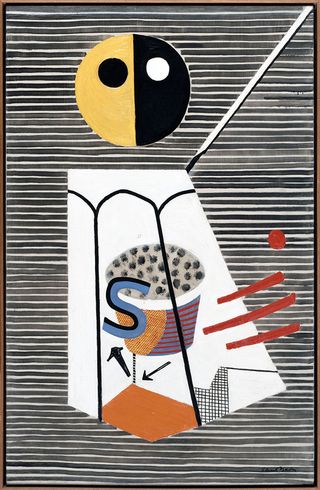
Not only was Davis a personal friend and favourite of Gertrude Vanderbilt Whitney, he was also a founding member of the Whitney Studio Club and had his first solo exhibition at the institution in 1926. Pictured: Salt Shaker, 1931
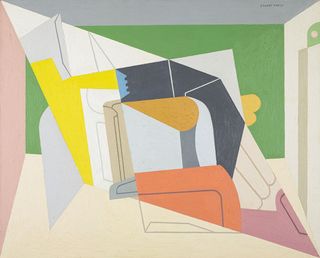
Throughout the exhibition, the show’s curators, Barbara Haskell and Harry Cooper, consistently remind viewers of Davis' individuality. Old and new works are placed side-by-side to demonstrate how motifs or ideas from the 1920s remained powerful to Davis over the years. Pictured: Egg Beater No. 2, 1928

While he was a true-blood American, Davis' sense of identity was not the idealised pastoral, but rather formed by the New York streets and Newark's hot jazz joints. Pictured: Town Square, 1929
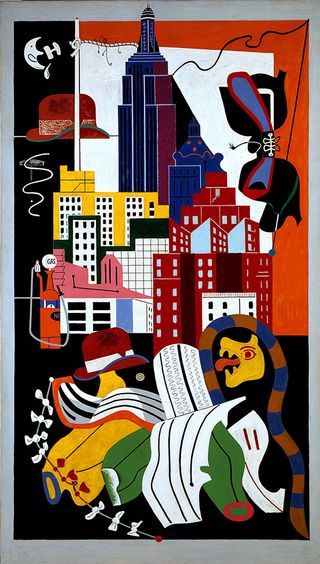
His fusion of dynamism and vivid colours led him to neither embrace abstraction fully nor to abandon figuration completely. Pictured: New York Mural, 1932
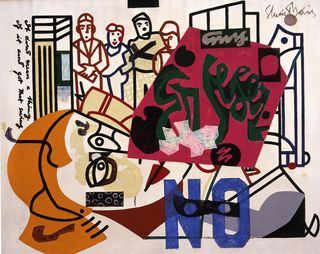
Throughout his oeuvre, he maintained a formal principle of using only ‘shallow space,’ so the canvas didn’t deceive or seduce unjustly. Pictured: American Painting, 1932/1942–54
INFORMATION
'Stuart Davis: In Full Swing' opens on 11 June and runs until 25 September. For more details, please visit the museum's website
All images courtesy of the Stuart Davis Estate and the Whitney Museum
ADDRESS
Whitney Museum of American Art
99 Gansevoort Street
New York, New York
Wallpaper* Newsletter
Receive our daily digest of inspiration, escapism and design stories from around the world direct to your inbox
Julie Baumgardner is an arts and culture writer, editor and journalist who's spent nearly 15 years covering all aspects of art, design, culture and travel. Julie's work has appeared in publications including Bloomberg, Cultured, Financial Times, New York magazine, The New York Times, Wall Street Journal, as well as Wallpaper*. She has also been interviewed for The Atlanta Journal-Constitution, Miami Herald, Observer, Vox, USA Today, as well as worked on publications with Rizzoli press and spoken at art fairs and conferences in the US, Middle East and Asia. Find her @juliewithab or juliebaumgardnerwriter.com
-
 Pininfarina Battista Reversario is a new one-off electric hypercar
Pininfarina Battista Reversario is a new one-off electric hypercarThe all-electric Pininfarina Battista Reversario is joining its aesthetic inverse in an ultra-select car collector’s garage. We take a look at a car built to a very precise order
By Jonathan Bell Published
-
 Fernando Jorge’s fluid diamond earrings show his curve appeal
Fernando Jorge’s fluid diamond earrings show his curve appealDiscover Brazilian jewellery designer Fernando Jorge's snake-like silhouettes and graphic shapes
By Hannah Silver Published
-
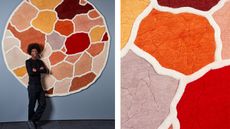 Abreham Brioschi debuts Ethiopia-inspired rugs for Nodus
Abreham Brioschi debuts Ethiopia-inspired rugs for NodusAbreham Brioschi teams up with luxury rug experts Nodus to translate visions from his heritage into a tactile reality
By Ifeoluwa Adedeji Published
-
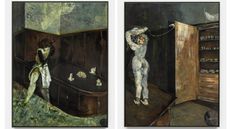 Guglielmo Castelli considers fragility and violence with painting series in Venice
Guglielmo Castelli considers fragility and violence with painting series in VeniceGuglielmo Castelli’s exhibition ‘Improving Songs for Anxious Children’ at Palazzetto Tito, Venice, explores childhood as the genesis of discovery
By Sofia Hallström Published
-
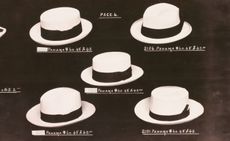 The Met’s ‘The Real Thing: Unpacking Product Photography’ dissects the avant-garde in early advertising
The Met’s ‘The Real Thing: Unpacking Product Photography’ dissects the avant-garde in early advertisingA new exhibition at The Metropolitan Museum of Art in New York explores the role of product photography and advertising in shaping the visual language of modernism
By Zoe Whitfield Published
-
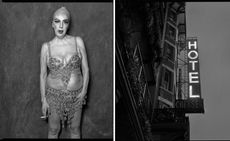 Tony Notarberardino’s Chelsea Hotel Portraits preserve a slice of bygone New York life
Tony Notarberardino’s Chelsea Hotel Portraits preserve a slice of bygone New York life‘Tony Notarberardino: Chelsea Hotel Portraits, 1994-2010’, on show at New York’s ACA Galleries, is the photographer’s ode to the storied hotel he calls home and its eclectic clientele
By Hannah Silver Published
-
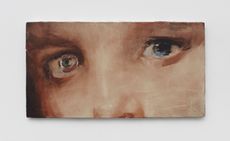 ‘Accordion Fields’ at Lisson Gallery unites painters inspired by London
‘Accordion Fields’ at Lisson Gallery unites painters inspired by London‘Accordian Fields’ at Lisson Gallery is a group show looking at painting linked to London
By Amah-Rose Abrams Published
-
 ‘LA Gun Club’: artist Jane Hilton on who’s shooting who
‘LA Gun Club’: artist Jane Hilton on who’s shooting who‘LA Gun Club’, an exhibition by Jane Hilton at New York’s Palo Gallery, explores American gun culture through a study of targets and shooters
By Hannah Silver Published
-
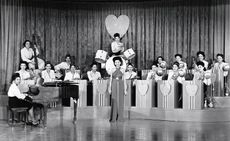 Detroit Institute of Arts celebrates Black cinema
Detroit Institute of Arts celebrates Black cinema‘Regeneration: Black Cinema 1898-1971’ at the Detroit Institute of Arts (DIA) brings lost or forgotten films, filmmakers and performers to a contemporary audience
By Anne Soward Published
-
 BLUM marks 30 years of Japanese contemporary art in America
BLUM marks 30 years of Japanese contemporary art in AmericaBLUM will take ‘Thirty Years: Written with a Splash of Blood’ to its New York space in September 2024, continuing its celebration of Japanese contemporary art in America
By Timothy Anscombe-Bell Published
-
 Todd Gray’s sculptural photography collages defy dimension, linearity and narrative
Todd Gray’s sculptural photography collages defy dimension, linearity and narrativeIn Todd Gray’s New York exhibition, he revisits his 40-year archive, fragmented into elaborated frames that open doors for new readings
By Osman Can Yerebakan Published